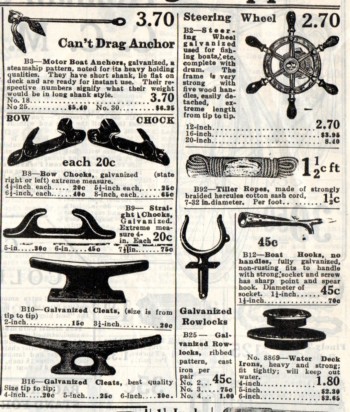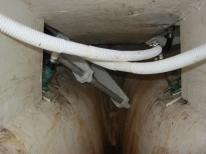The ultimate compliment to a general store was that it could supply the shopper with anything from a needle to an anchor. When R.T. Holman opened his store in Summerside in 1857 he was intent in meeting the needs of his customers and his store kept expanding its lines of goods and its showrooms and warehouses to fill every need. Even in the 20th century, when the store had expanded to Charlottetown the range of goods was immense.
As I write I have to hand a copy of the 1925 spring and summer mail order catalogue (the 36th edition) which went out to consumers in Quebec, New Brunswick, Nova Scotia, P.E.Island, and even to the Dominion of Newfoundland. The more than 120 pages of the catalogue show goods which ranged from fedoras to fish hooks, from flapper dresses to fox wire and from flea powder to framed pictures.
 While Holman’s was not a specialized chandlery shop it did carry a respectable line of goods for fishermen and boaters. Anchors and blocks and oars and boat hooks served many needs and the page has items that are no longer commonly found except in specialty shops – sail
While Holman’s was not a specialized chandlery shop it did carry a respectable line of goods for fishermen and boaters. Anchors and blocks and oars and boat hooks served many needs and the page has items that are no longer commonly found except in specialty shops – sail  rings – 8 cents each, for making your own sails, along with thimbles, twine, sail needles and beeswax, trawl hooks and tarred cotton lines. There were boat hooks and tiller ropes, and for the new-fangled gasoline engines there were galvanized gasoline boat tanks, copper tubing and sleeves, priming cups and asbestos packing. If you had a lobster packing plant you might be interested in boiler tube cleaners, lobster cleavers or a home soldering outfit to seal the tins. Most goods were generically anonymous but the “Can’t Drag Anchor” especially constructed for motor boats , ready for instant use – was an exception. Another branded product was Union Jack brand copper paint.
rings – 8 cents each, for making your own sails, along with thimbles, twine, sail needles and beeswax, trawl hooks and tarred cotton lines. There were boat hooks and tiller ropes, and for the new-fangled gasoline engines there were galvanized gasoline boat tanks, copper tubing and sleeves, priming cups and asbestos packing. If you had a lobster packing plant you might be interested in boiler tube cleaners, lobster cleavers or a home soldering outfit to seal the tins. Most goods were generically anonymous but the “Can’t Drag Anchor” especially constructed for motor boats , ready for instant use – was an exception. Another branded product was Union Jack brand copper paint.
 The most intriguing (or perhaps frightening) of the items on offer were used life preservers:
The most intriguing (or perhaps frightening) of the items on offer were used life preservers:
Life Preservers, second-hand, but in good shape. Flat style fastening around the waist with straps over shoulders. Great for teaching the boys to swim; every boat should have two or three – each 50 cents.
I have a vision of a heavily burdened postman arriving with my Holman’s order. A bundle of still damp, salt-stained parcels of canvas and cork with the stencilled “R.M.S. Titanic” still visible. I mean – where else would you have a wholesale supplier of used life preservers? As I sit at my desk and look up at my grandfather’s photo I ask myself “Would you buy a used life-preserver from this man?”
 Elsewhere in the catalogue other nautical needs are met. Page 16 featured oiled clothing – apron pants, jackets, aprons, Storm King Hats, and the strangely disturbing Oiled Petticoat in size 1 and 2. ($2.85). For not much more you could get the whole Fisherman’s Rubber Suit. Does the satisfied smile on the pipe-smoking rubber-clad gent suggest that beneath all he is wearing an oiled petticoat?
Elsewhere in the catalogue other nautical needs are met. Page 16 featured oiled clothing – apron pants, jackets, aprons, Storm King Hats, and the strangely disturbing Oiled Petticoat in size 1 and 2. ($2.85). For not much more you could get the whole Fisherman’s Rubber Suit. Does the satisfied smile on the pipe-smoking rubber-clad gent suggest that beneath all he is wearing an oiled petticoat?
Yes, in 1925 Holman’s could provide you with a needle, or an anchor and just about anything in between. If it wasn’t in the Holman’s catalogue you probably didn’t need it anyway.







